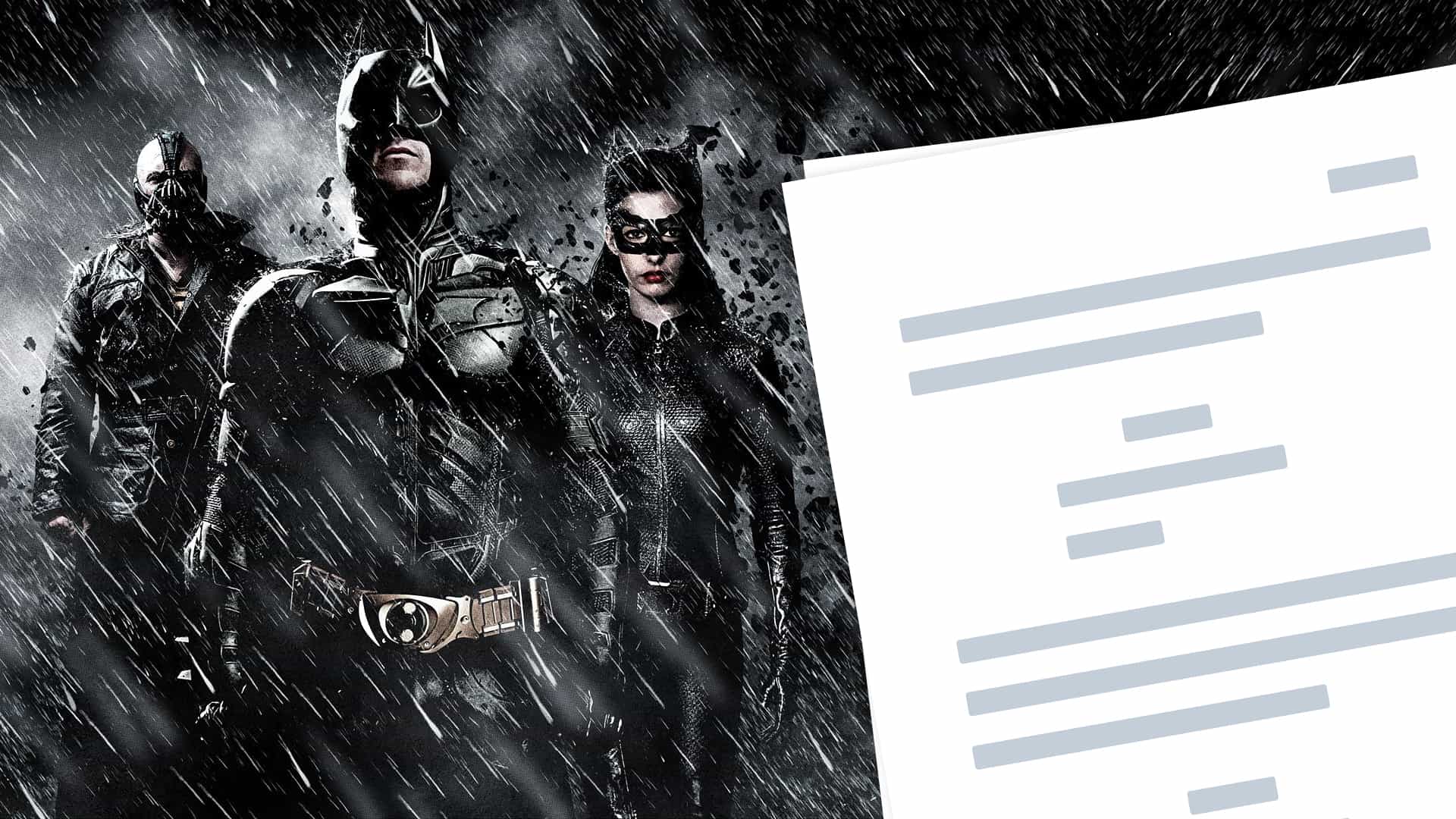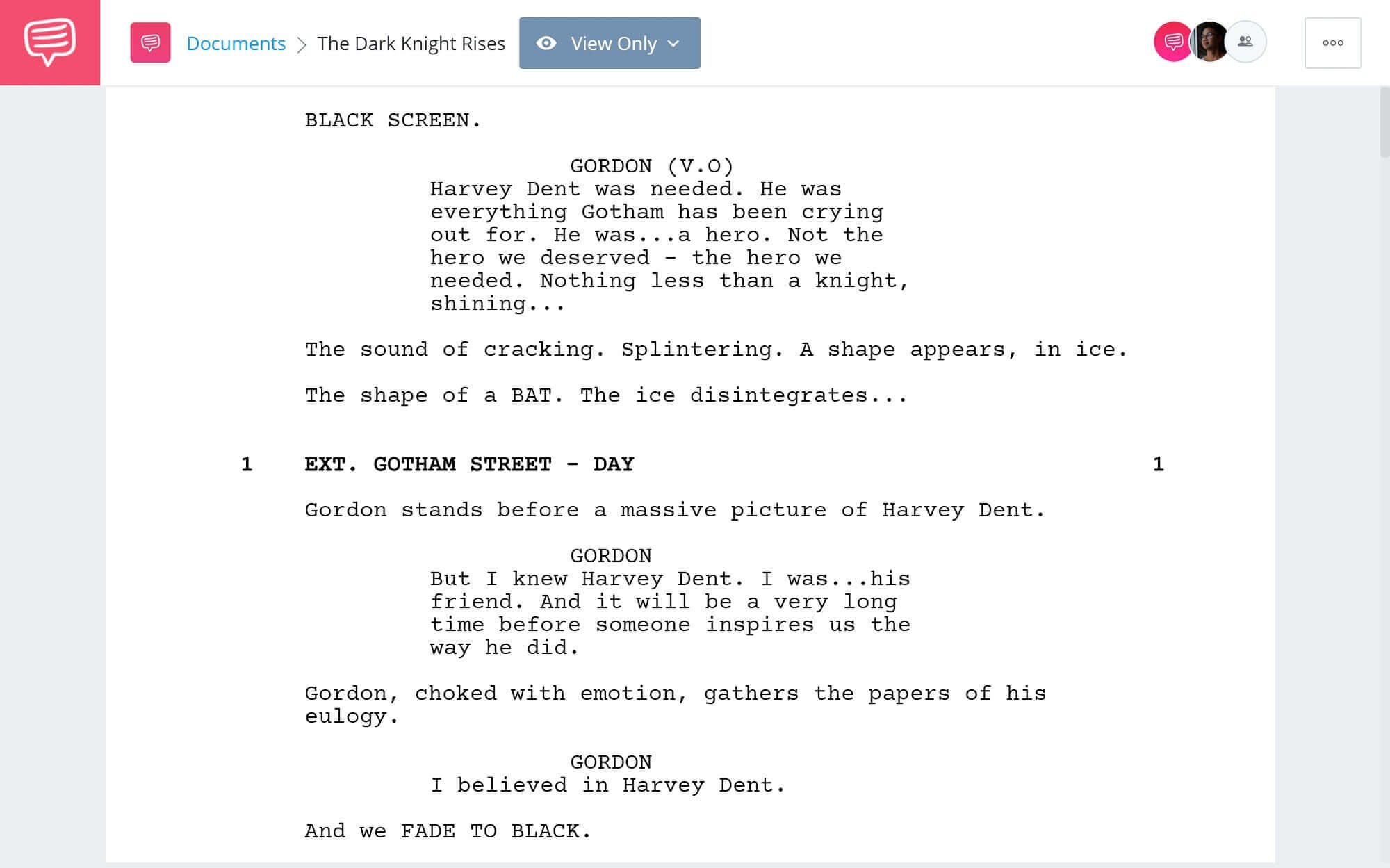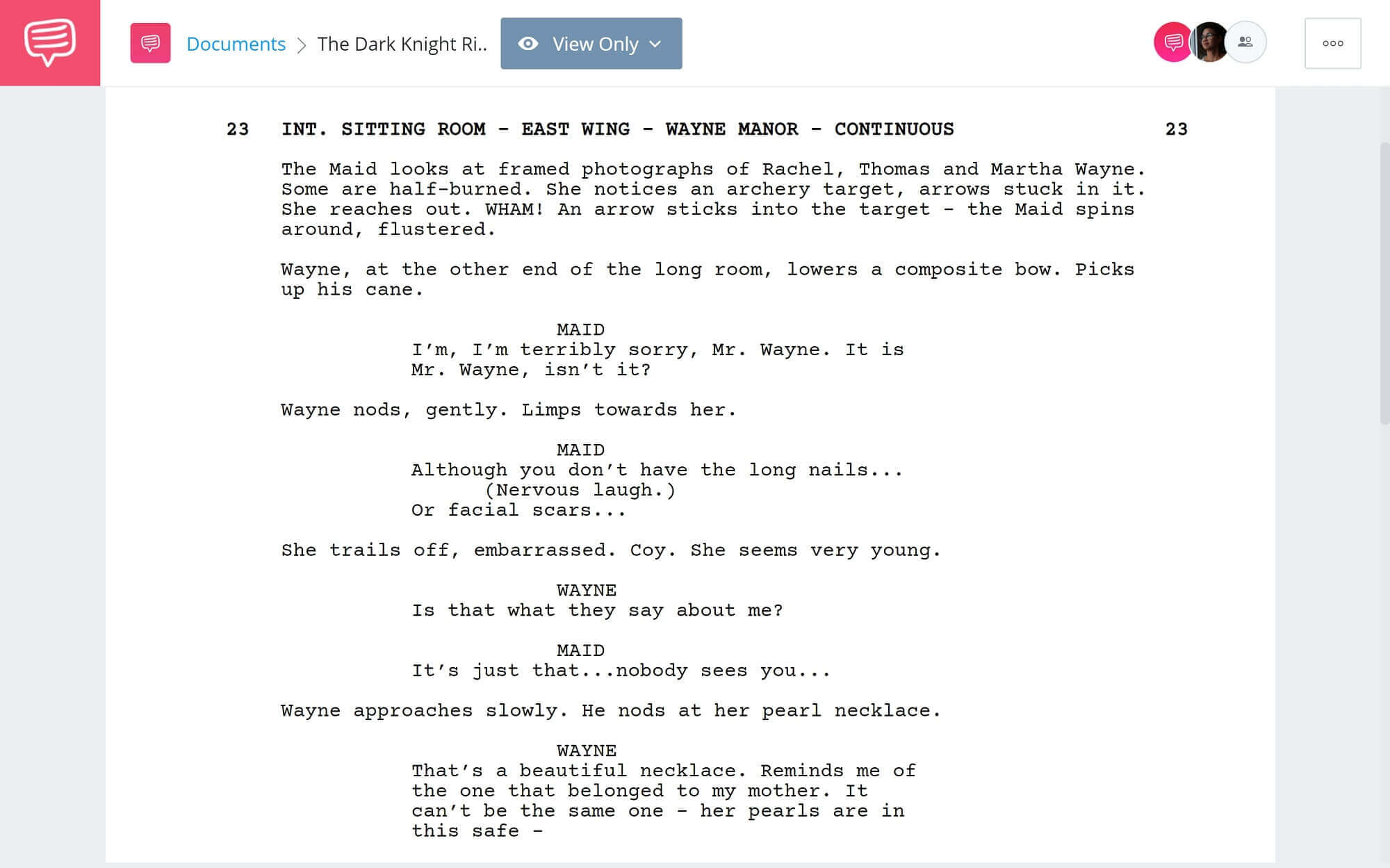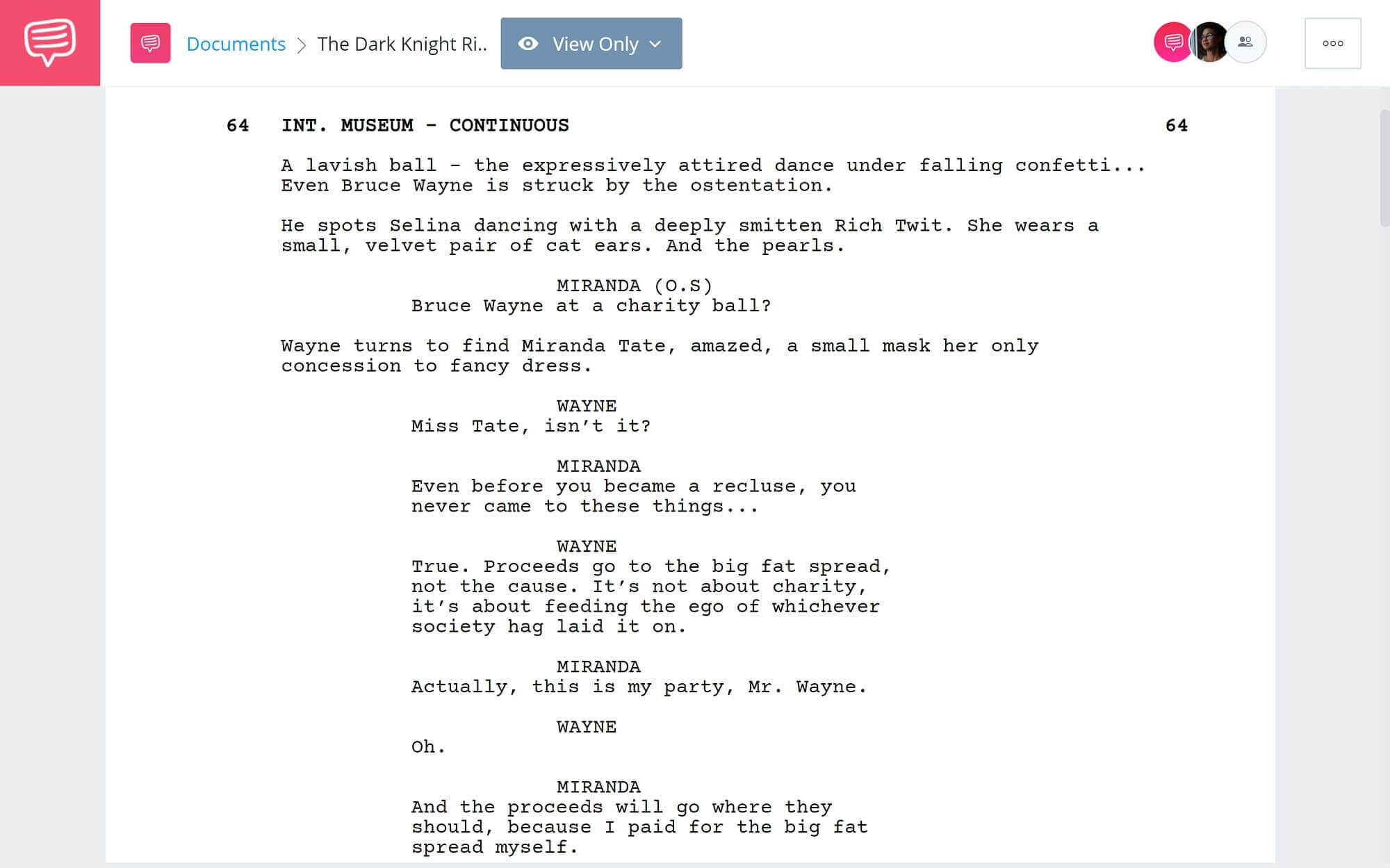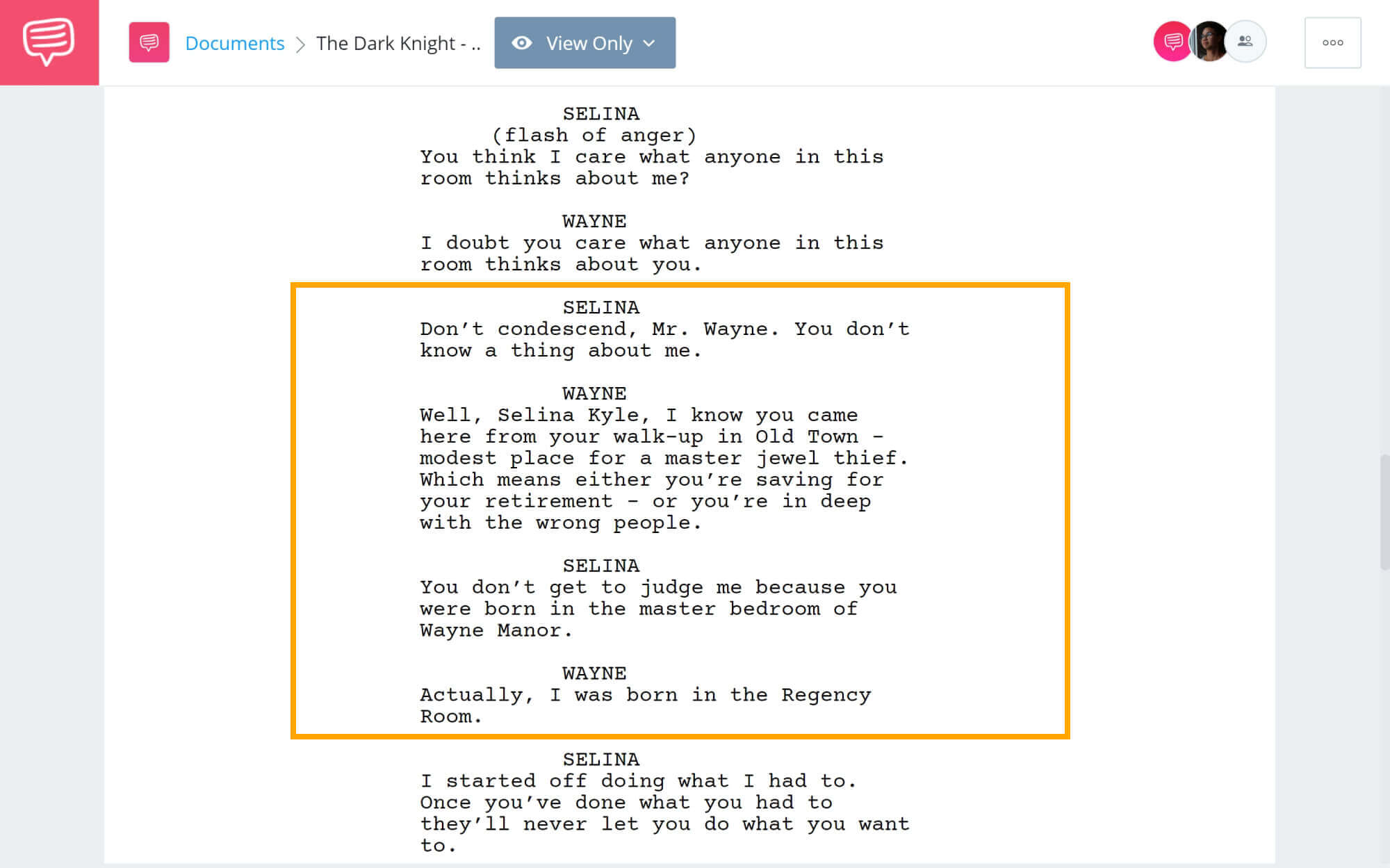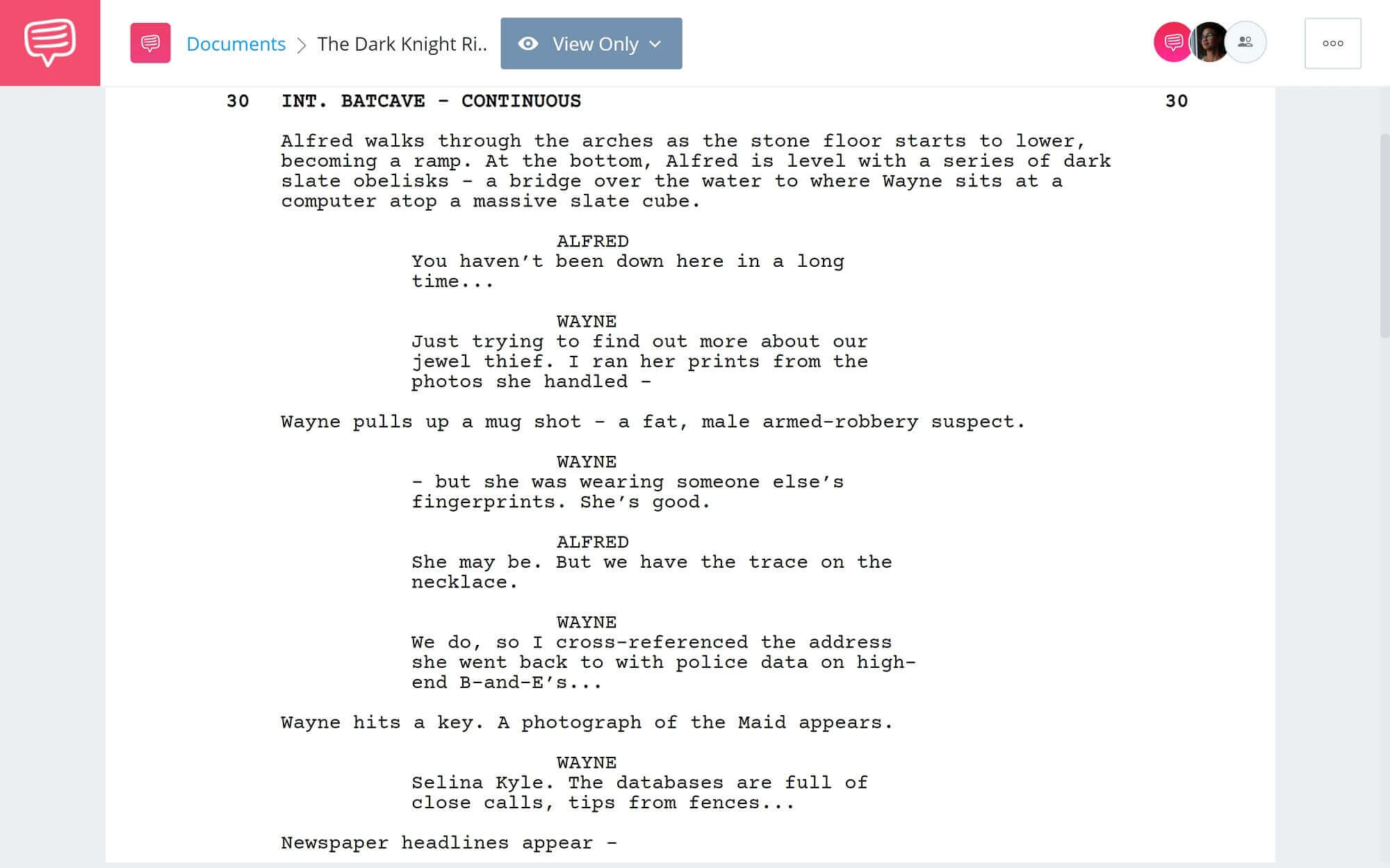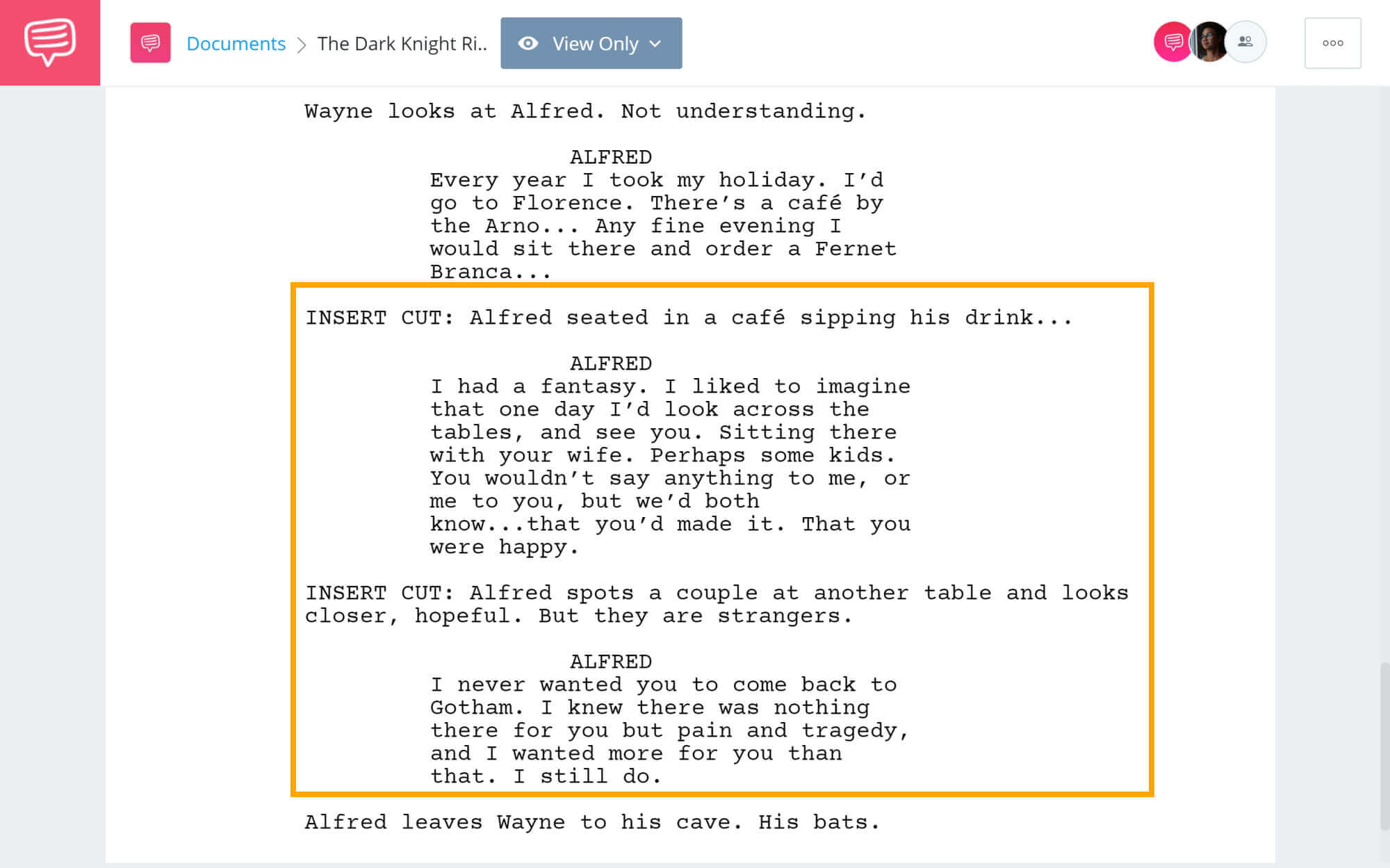The Dark Knight Rises script laid the groundwork for the final film in Christopher Nolan’s Batman trilogy. Although it wasn’t as well received as its predecessor, The Dark Knight Rises still had plenty of great moments. We’re going to break down The Dark Knight Rises script by looking at characters, dialogue, and story-arcs. But first, let’s remind ourselves of who wrote The Dark Knight Rises screenplay. Make sure to download a PDF copy of the script below to read along!
WHO WROTE THE DARK KNIGHT RISES SCRIPT?
Written by Jonathan Nolan and Christopher Nolan, based on a story by Christopher Nolan and David S. Goyer.
Jonathan Nolan is a prolific screenwriter and author who has co-written several feature length scripts with his brother Christopher. Jonathan has also served as a writer/director/EP on shows like Person of Interest and Westworld.
Christopher Nolan is a highly decorated filmmaker who has directed some of the most iconic movies of the 21st century. His films, which include but are not limited to Memento, Inception, and Dunkirk, have been nominated for 34 Academy Awards.
David S. Goyer is writer/director/producer who has worked in film, video games, comic books, and literature. Some of his most famed credits are for writing Call of Duty: Black Ops, Batman Begins, and Man of Steel.
THE DARK KNIGHT RISES PLOT
STRUCTURE OF THE DARK KNIGHT RISES SCREENPLAY
Here is the story structure for The Dark Knight Rises screenplay:
Exposition
A masked villain named Bane hijacks a plane from CIA operatives. In Gotham, the deceased former D.A. Harvey Dent (Two-Face) is being honored (falsely) as a hero of the city. It’s been eight years since anyone has seen ‘the Batman’ or Bruce Wayne in public.
Inciting Incident
A young maid sneaks into Bruce’s private residence and steals his mother’s pearls. He attempts to stop her but is disabled easily. Shortly after, Bruce realizes that she was after his fingerprints not the pearls and is prompted to pursue her.
Plot Point I
Police commissioner Gordon tasks a young officer named Blake with investigating reports of commotion in the sewers. Blake discovers the dead body of a teenage orphan in a sewer grate.
Plot Point II
Bruce discovers that the maid is actually a fugitive named Selina Kyle (Catwoman). At a banquet-ball hosted by Wayne Enterprise executive Miranda Tate, Selina tells Bruce that a “storm is coming.”
Plot Point III
Bruce’s butler and greatest friend Alfred Pennyworth, pleads with him to hang up the cowl for good, and instead use his intellect and wealth to save the city. Alfred says that he always dreamed that one day he’d see Bruce at a cafe, happy, with a woman at his side. But Alfred expresses that he now believes Bruce is on a path to assured self-destruction.
Midpoint I
Bane raids the stock exchange and uses Bruce’s fingerprints to order fraudulent stock-puts, which essentially bankrupts him. With the help of his friend Lucius Fox, Bruce gives executive control of Wayne Enterprises to Miranda.
Rising Action
Bruce shows Miranda his decommissioned nuclear fusion reactor. He tells her that the reactor is capable of powering Gotham with clean, renewable energy, but in the wrong hands, it could be turned into a bomb.
Midpoint II
Bruce confronts Bane but is severely overpowered. Bane knocks Bruce unconscious, breaks his back, then imprisons him in the hole where he was ‘born.’
Rising Action II
With Batman gone, Gotham falls into chaos. Bane blows up a football stadium, kills the mayor, and institutes Martial law. Thousands of prisoners are released from Blackgate, including the villain Scarecrow, who becomes judge, jury, and executioner of Gotham’s elite.
Climax
While imprisoned in the hole, Bruce is told a story of a child who once escaped. He begins to train his body but is unable to make a leap across the chasm. A prisoner tells him that he must embrace the darkness and jump without a harness. Bruce heeds his advice and escapes.
Climax Part II
In Gotham, Bane has turned Bruce’s fusion reactor into a bomb. He says that a citizen of the city has been armed with its detonator and if anybody should try to leave, they’ll be forced to trigger it.
Finale
Bruce returns to Gotham and confronts Bane, thinking that he has the trigger. However, he’s backstabbed by Miranda, who reveals herself to be the child from the ‘hole,’ Talia al-Ghul (Ra’s al-Ghul’s daughter). Selina returns in the nick of time and kills Bane while Talia escapes with the detonator.
Finale Part II
Talia is killed in a crash orchestrated by Gordon. Meanwhile, the bomb is still rigged to go off. Bruce attaches the bomb to his plane and flies off into the sunset.
Denouement
Some time later, a Batman statue is erected in Gotham. Blake inherits map coordinates to the Batcave from Bruce’s estate, given to him under his legal name ‘Robin.’ Somewhere abroad, Alfred sits down at the cafe he described earlier, and sees Bruce and Selina enjoying a morning together.
The Dark Knight Rises Plot Design
How to craft a strong opening
Now that we’ve reviewed The Dark Knight Rises summary, let’s dive into some analysis.
Perhaps the biggest strength of The Dark Knight Rises script is how it crafts a strong three-act story arc — in other words, a clear beginning, middle, and end. It sounds really easy, but plenty of screenwriters get lost in the minutia.
So, what makes The Dark Knight Rises screenplay work so well? Let’s start at the beginning:
Bruce Wayne is a hermit. Batman is gone. The city is safe but it cost Bruce his love. It’s very clear in the beginning of the script where things stand; there’s stability but no resolution. Remember, The Dark Knight Rises is the third (and last) of a franchise series. So the script has to resolve not only the arc of this film but that of the entire series.
This brings us to the inciting incidents. Within the arc of The Dark Knight Rises, the incident serves to introduce Selina Kyle, and create conflict that will materialize later on. Within the context of Nolan’s series of films, the incident serves to show how the toll of Bruce’s internal and external conflict has beaten him down.
In the end, these two perspectives work towards the same end. Let’s take a look at how the Nolan Brothers use plot and dialogue to entice Bruce Wayne back into the fray:
The Dark Knight Rises Screenplay • Read Catwoman’s Introduction
Okay, some aspects of this scene may be exaggerated, like the crippled state of Bruce and his reliance on a flimsy cane. But through that exaggeration, we’re able to see what’s become of his mind and body. This is not the Bruce Wayne that we last saw in The Dark Knight. He’s beaten, bruised, and broken — but his story is not yet complete.
Throughout The Dark Knight Rises script, we’re reminded of the pain Bruce endured. It’s one thing to read that, it’s another to see it. Let’s take a look at how the scene in which Alfred confronts Bruce about his pain comes together in the film.
The Dark Knight Rises • ‘I Won’t Bury You’'
Bruce Wayne’s internal conflict is the emotional core of The Dark Knight Rises. Here, the Nolan Brothers frame Alfred against Bruce to externalize that conflict. In no way are Alfred and Bruce really at odds with each other. It’s really that Bruce is at odds with himself and Alfred hates to see him that way.
These scenes take place within the first third of The Dark Knight Rises script and expertly sets the plot in motion and sets up the thematic conflict to be resolved by the end.
The Dark Knight Rises Quotes and World Building
Dialogue meets production design
It’s no secret that The Dark Knight Rises had its fair share of critics; many of whom were critical of the film’s exposition-laden dialogue. It’s certainly a fair criticism, but let’s think about what the film was tasked with doing:
- Be entertaining
- Have a strong story arc
- Resolve themes and topics from the series
- Explain what’s going on for new Batman viewers
Achieving those four things aren’t easy. Although it was directed by Christopher Nolan, The Dark Knight Rises was still a studio film. Remember, studios are businesses, and businesses are rightfully interested in making money — studio films usually aim for the widest audience possible, which is hard to do with the last film in a series.
There are scenes in The Dark Knight Rises that work incredibly well though, both within the framework of the series and on their own. This next scene in particular is a great example:
The Dark Knight Rises Screenplay • Read the Ballroom Scene
What is it about this scene that works so well? Notice anything about the scene descriptions? The ingredients that will become the production design? Let’s start with the setting. Here we see Bruce brave the public for the first time in nearly eight years. He abandons the cape and cowl and ventures back into the city as a business magnate, not a masked crusader. But where does he go for his first foray back into the ‘real’ world? Ah yes, of course, he goes to a masquerade party.
There he sees Selina, who is wearing “a small, velvet pair of cat ears,” a clever way of foreshadowing her alternate identity ‘Catwoman.’ It may be a bit on the nose, but it works within the context of the scene. The Dark Knight Rises characters constantly walk the line between comic and grounded, which is a tightrope Nolan successfully walked in each film.
There’s just one character in the scene who isn’t wearing a mask, Bruce Wayne. Ah, that could be in reference to the idea that ‘Bruce Wayne’ is a mask in and of himself, hiding who really is at heart.
Let’s look at the final cut of this scene, then we’ll talk about its best part.
The Dark Knight Rises • ‘A Storm is Coming’
From beginning to end, the dialogue in this scene is crisp, poetic, and nuanced. It certainly helps to have great actors like Christian Bale and Anne Hathaway delivering the lines, but even at a structural level, the dialogue is just really vibrant.
Writing exposition in film can be a screenwriter’s worst enemy, but by concealing it in dialogue behind major topics of the story, you can start to make exposition more of a friend. This little exchange shows us how the Nolan Brothers do a great job of writing backstory into dialogue:
The Dark Knight Rises Screenplay • Read Example of Exposition in Dialogue
What’s the result of this exchange? Well, first and foremost, it establishes chemistry between the characters, somewhere in between flirtation and argumentation. Second, it gives us backstory on Selina’s character — it tells us where she’s from, what she does, and what her motives may be. All of this is done in a very digestible, and realistic way.
The Dark Knight Rises Ending
Character and thematic resolution
It’s no easy task pulling off a satisfying ending. We’ve seen dozens of TV shows and films struggle to find cohesion in its final moments. I’d say that The Dark Knight Rises ending does a tremendous job of bringing closure to Nolan’s Batman trilogy; for one reason and one reason only.
To feel the weight of The Dark Knight Rises ending, we have to go back to the first act, when Alfred tells Bruce that he always dreamed he’d get away from Gotham. Let’s dive back into the script to see how this earlier interaction unfolds:
The Dark Knight Rises Screenplay • Read the ‘Cafe Dream’ Scene
In this scene, Alfred basically lays out what the denouement, or resolution of the series, is going to be. He dreams that Bruce escapes Gotham with a woman and finds peace within himself, somewhere far away. He even tells us where this “far away” is!
The Dark Knight Rises Screenplay • Read the Denouement Foreshadowing
In the end, this dream becomes a reality. Let’s see how The Dark Knight Rises ending comes together in the film:
The Dark Knight Rises • Ending Explained
Here, we see The Dark Knight Rises ending explained:
All of the various story arcs together. Lucius learns that Bruce fixed the autopilot in the Batwing, which is how he was able to escape. Blake is given coordinates in Bruce’s will, which brings him to the Batcave. Alfred goes to the cafe by the Arno and sees Bruce sitting with Selina, and takes solace in the fact that he made it out of Gotham.
Related Posts
UP NEXT
Best Bane Quotes in TDKR
We’ve gone over The Dark Knight Rises script in detail, but there’s one character who we didn’t look at as deeply as the others — the Rogues Gallery’s Bane. Few villains in Batman cinema history have had as iconic of quotes as Bane. In this next article, we rank the best Bane quotes in TDKR. Time to go mobile!
